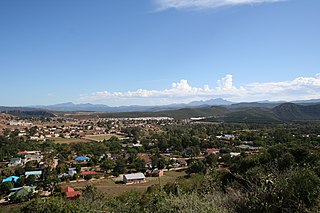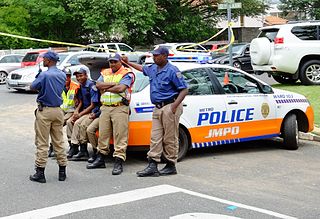
The Cape Flats is an expansive, low-lying, flat area situated to the southeast of the central business district of Cape Town.

Coloureds are a multiracial ethnic group native to Southern Africa who have ancestry from more than one of the various populations inhabiting the region, including Khoisan, Bantu, European, Austronesian, South Asian or East Asian. Because of the combination of ethnicities, different families and individuals within a family may have a variety of different physical features. Coloured was a legally defined racial classification during apartheid.

In South Africa, the terms township and location usually refer to the often underdeveloped racially segregated urban areas that, from the late 19th century until the end of apartheid, were reserved for non-whites, namely Indians, Africans and Coloureds. Townships were usually built on the periphery of towns and cities. The term township also has a distinct legal meaning in South Africa's system of land title, which carries no racial connotations.

The Population Registration Act of 1950 required that each inhabitant of South Africa be classified and registered in accordance with their racial characteristics as part of the system of apartheid.

The Separate Representation of Voters Act No. 46 was introduced in South Africa on 18 June 1951. Part of the legislation during the apartheid era, the National Party introduced it to enforce racial segregation, and was part of a deliberate process to remove all non-white people from the voters' roll and revoke the Cape Qualified Franchise system.
The Mines and Work Act was a piece of legislation in South Africa, originally passed in 1911 and amended in 1912 and 1926 before undergoing further changes in 1956 and 1959. This act legally established South Africa's employment "colour bar." and was enacted to establish the duties and responsibilities of workers in Mines and Works in South Africa.
Chinese South Africans are overseas Chinese who reside in South Africa, including those whose ancestors came to South Africa in the early 20th century until Chinese immigration was banned under the Chinese Exclusion Act of 1904. Chinese industrialists from the Republic of China (Taiwan) who arrived in the 1970s, 1980s and early 1990s, and post-apartheid immigrants to South Africa now outnumber locally-born Chinese South Africans.
In South Africa, pass laws were a form of internal passport system designed to segregate the population, manage urbanization, and allocate migrant labor. Also known as the natives' law, pass laws severely limited the movements of not only black African citizens, but other people as well by requiring them to carry passbooks when outside their homelands or designated areas. Before the 1950s, this legislation largely applied to African men, and attempts to apply it to women in the 1910s and 1950s were met with significant protests. Pass laws were one of the dominant features of the country's apartheid system until it was effectively ended in 1986.

Apartheid was a system of institutionalised racial segregation that existed in South Africa and South West Africa from 1948 until the early 1990s. Apartheid was characterized by an authoritarian political culture based on baasskap, which ensured that South Africa was dominated politically, socially, and economically by the nation's minority white population. According to this system of social stratification, white citizens had the highest status, followed by Asians and Coloureds, then black Africans. The economic legacy and social effects of apartheid continue to the present day.
Group Areas Act was the title of three acts of the Parliament of South Africa enacted under the apartheid government of South Africa. The acts assigned racial groups to different residential and business sections in urban areas in a system of urban apartheid. An effect of the law was to exclude people of color from living in the most developed areas, which were restricted to Whites. It required many people of color to commute large distances from their homes to be able to work. The law led to people of color being forcibly removed for living in the "wrong" areas. The majority that was people of color, were given much smaller areas to live in than the white minority who owned most of the country. Pass Laws required people of color to carry pass books and later 'reference books', similar to passports, to enter the 'white' parts of the country.

The South Africa Act 1909 was an Act of the British Parliament which created the Union of South Africa from the British colonies of the Cape of Good Hope, Natal, Orange River Colony, and Transvaal. The Act also made provisions for admitting Rhodesia as a fifth province of the Union in the future, but Rhodesian colonists rejected this option in a referendum held in 1922. The South Africa Act was the third major piece of legislation passed by the Parliament of the United Kingdom with the intent of uniting various British colonies and granting them some degree of autonomy. Earlier, the British North America Act, 1867 had united three colonies and the Commonwealth of Australia Constitution Act, 1900 had united the Australian colonies.
The system of racial segregation in South Africa known as apartheid was implemented and enforced by many acts and other laws. This legislation served to institutionalise racial discrimination and the dominance by white people over people of other races. While the bulk of this legislation was enacted after the election of the National Party government in 1948, it was preceded by discriminatory legislation enacted under earlier British and Afrikaner governments. Apartheid is distinguished from segregation in other countries by the systematic way in which it was formalised in law.

Indian South Africans are South Africans who descend from indentured labourers and migrants who arrived from British India during the late 1800s and early 1900s. The majority live in and around the city of Durban, making it one of the largest "Indian" populated cities outside of India.

Law enforcement in South Africa is primarily the responsibility of the South African Police Service (SAPS), South Africa's national police force. SAPS is responsible for investigating crime and security throughout the country. The "national police force is crucial for the safety of South Africa's citizens" and was established in accordance with the provisions of Section 205 of the Constitution of South Africa.
Racism in South Africa comprises negative attitudes and ideas on race or ethnicity which have been reflected in discriminatory laws, practices and actions against racial or ethnic groups throughout the history of South Africa. Before universal suffrage was achieved in 1994, white South Africans, especially Afrikaners during the period of Apartheid, enjoyed various legally or socially sanctioned privileges and rights which were denied to others. Examples of racism over the course of South Africa's history include forced removals, racial segregation, uneven resource distribution, and disenfranchisement. Racial politics remain a major phenomenon.

The Coloured Persons Communal Reserves Act of 1961, was an Apartheid South Africa piece of legislation, which was enacted to apply the Mission Stations and Communal Reserves Act 1909, of the Cape of Good Hope, to coloured persons settlement areas within the meaning of the Coloured Persons Settlement Areas (Cape) Act, 1930, to repeal the latter Act and to provide for matters incidental thereto.

The Representation of Natives Act No 12 of 1936 was legislation passed in South Africa which further reduced black rights at the time. The Cape province had a qualified franchise which had allowed a small number of blacks in the Cape to vote for the common roll in terms of the Cape Qualified Franchise. The qualified franchise dated back to the pre-Union period, when the Cape was a separate British colony; it also excluded poorer white men. The 1936 Act removed blacks to a separate roll – and halted the right to run for office; other earlier legislation removed the qualifications imposed in the Cape on whites.

The Cape Qualified Franchise was the system of non-racial franchise that was adhered to in the Cape Colony, and in the Cape Province in the early years of the Union of South Africa. Qualifications for the right to vote at parliamentary elections were applied equally to all men, regardless of race.

Thembalethu is a township in Western Cape, South Africa. The township is on the Garden Route and falls part of the George Municipality. The name of the township "Thembalethu" is Xhosa meaning "Our Hope".

Homelessness in South Africa dates back to the apartheid period. Increasing unemployment, lack of affordable housing, social disintegration, and social and economic policies have all been identified as contributing factors to the issue. Some scholars argue that solutions to homelessness in South Africa lie more within the private sphere than in the legal and political spheres.











